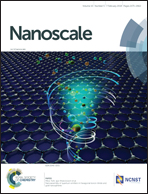The role of polyethylenimine in enhancing the efficiency of quantum dot light-emitting devices†
Abstract
Although the use of polyethylenimine (PEI) in quantum dot light-emitting devices (QDLEDs) has recently been found to improve efficiency, the mechanism behind this increase has been disputed in the literature. In this work, we conduct investigations to elucidate the role of PEI in enhancing QDLED efficiency. Spectroscopic studies of devices with a phosphorescent marking layer reveal that the PEI layer increases, rather than decreases, the generation of excitons within the hole transporting layer indicative of increased electron injection. Delayed electroluminescence measurements corroborate these findings as devices with a PEI interlayer exhibit a greater concentration of excess mobile and trapped electrons. We attribute the improvement in efficiency despite the ensuing increased charge imbalance within the devices to the passivation of exciton quenching at the ZnO/QD interface. The increase in efficiency predominantly occurs over low driving currents which is particularly attractive for the brightness targets of display applications. Furthermore, despite the increased charge imbalance, the PEI passivation layer appears to have little effect on QDLED stability. This shows that excess electrons and Auger quenching by unneutralized electrons are not detrimental to QDLED stability.



 Please wait while we load your content...
Please wait while we load your content...